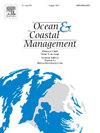Effects of mangrove age on water quality and deposit sediment layer in integrated mangrove-shrimp farming systems: a case study in Mekong Delta, Vietnam
IF 4.8
2区 环境科学与生态学
Q1 OCEANOGRAPHY
引用次数: 0
Abstract
Water quality plays a crucial role as a natural indicator in evaluating shrimp farming feasibility, closely linked to sediment characteristics. However, knowledge about how mangrove age affects water quality and sediment remains limited in mangrove-shrimp models. This study aimed to address this gap by collecting water and sediment samples from integrated mangrove-shrimp systems with three different mangrove ages in Ca Mau province, Vietnam, where Rhizophora apiculata is the dominant species in these systems. Water samples were collected twice per tide: (1) one day before water discharge for shrimp harvesting, and (2) one day after water intake into grow-out ponds. Sediment samples were taken to display sediment profiles and analyze organic matter. Linear mixed-effects models were employed to identify significant differences in water and sediment parameters among various mangrove age groups. Results indicated that mangrove age substantially affected pH, DO, N-NH3, H2S, and total organic carbon, but not N-NO2, N-NO3, N-NH4, and TN. The first sediment layer was thickest in mangroves over 10 years old, followed by those aged 6–9 years, and thinnest in those under 5 years old. Litterfall accumulation in the bottom pond was greatest in older mangrove groups. Findings revealed significant relationships between the first sediment layer and various water parameters, emphasizing the importance of managing this layer for suitable water quality in shrimp farming. Based on linear regression, dredging is recommended if the top sediment layer is approximately 10-cm thick to maintain good water quality. Furthermore, results confirmed that water exchange enhances water quality, potentially promoting shrimp survival and productivity.
红树林年龄对红树林-对虾综合养殖系统水质和沉积物层的影响——以越南湄公河三角洲为例
水质是评价对虾养殖可行性的重要自然指标,与沉积物特征密切相关。然而,关于红树林年龄如何影响水质和沉积物的知识在红树林虾模型中仍然有限。本研究旨在通过收集越南金茂省三种不同红树林年龄的红树林-虾综合系统的水和沉积物样本来解决这一差距,其中尖根霉是这些系统中的优势物种。每个潮汐采集两次水样:(1)放水捕虾前一天,(2)取水进入生长池后一天。采集沉积物样本以显示沉积物剖面并分析有机质。采用线性混合效应模型确定了不同红树林年龄组间水沙参数的显著差异。结果表明,树龄对土壤pH、DO、N-NH3、H2S和总有机碳的影响不显著,但对N-NO2、N-NO3、N-NH4和TN的影响不显著。树龄≥10年时第一层沉积物最厚,6-9年时次之,5年时最薄。底部池塘的凋落物积累在较老的红树林群落中最大。研究结果揭示了第一沉积物层与各种水参数之间的显著关系,强调了对第一沉积物层的管理对虾养殖中适宜的水质的重要性。根据线性回归,如果顶部沉积物层厚度在10cm左右,建议进行疏浚,以保持良好的水质。此外,研究结果证实,水交换改善了水质,可能促进对虾的生存和生产力。
本文章由计算机程序翻译,如有差异,请以英文原文为准。
求助全文
约1分钟内获得全文
求助全文
来源期刊

Ocean & Coastal Management
环境科学-海洋学
CiteScore
8.50
自引率
15.20%
发文量
321
审稿时长
60 days
期刊介绍:
Ocean & Coastal Management is the leading international journal dedicated to the study of all aspects of ocean and coastal management from the global to local levels.
We publish rigorously peer-reviewed manuscripts from all disciplines, and inter-/trans-disciplinary and co-designed research, but all submissions must make clear the relevance to management and/or governance issues relevant to the sustainable development and conservation of oceans and coasts.
Comparative studies (from sub-national to trans-national cases, and other management / policy arenas) are encouraged, as are studies that critically assess current management practices and governance approaches. Submissions involving robust analysis, development of theory, and improvement of management practice are especially welcome.
 求助内容:
求助内容: 应助结果提醒方式:
应助结果提醒方式:


